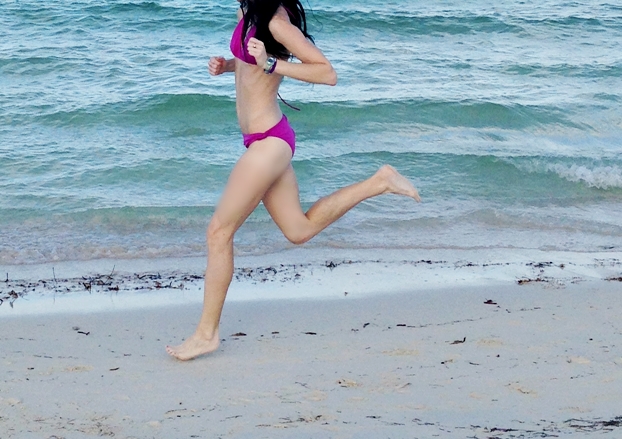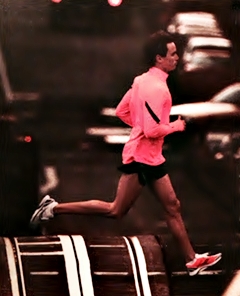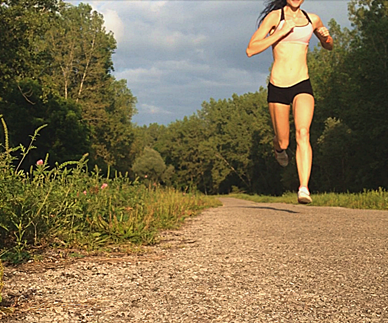When you are running barefooted, you don’t want to heel strike. The most forceful interaction with the ground in running is running with a heel strike, especially when you’re barefoot. So, when running barefoot, how should we be striking the ground with our feet? The evolutionary answer turns out to be with a forefoot strike, not a heel strike.

Don’t Heel Strike When Running Barefooted
Over the eons, the human foot and hind leg have developed spring-like properties that appear to function optimally with a forefoot strike running style which may allow distance running to be less costly and more safe compared to heel striking while running barefoot.
And, runners who wear thick cushioned heeled running shoes are more likely to heel strike than habitual barefoot runners.
Unfortunately, common running related injuries such as ankle inversion injuries are not documented in habitually barefoot running populations such as Ethiopia where these runners are mostly forefoot, or midfoot strikers.
Comparatively, ankle inversion injuries are well documented in habitually shod populations of which heel strikers account for the majority of these runners.

So, is it the shoes that cause ankle injuries in runners? Or, is it heel strike mechanics that results in ankle injury? Or, is it a combination of both?
If humans evolved as barefoot runners, could barefoot running prevent ankle injury? Not if you run on your heels.
Running Barefoot On the Heel Causes Ankle Inversion Injury
A recent study by Rice et al. found that barefoot running, if heel strike is maintained, may not prevent ankle injury as ankle inversion was not reduced with barefoot running.
Further, the barefoot-heel strikers in the study had high medially concentrated pressure at heel-off as well as high M1 (metatarsal bone of big toe) peak pulse pressure, both of which are risk factors for ankle inversion injury in runners.
Rice and her colleagues pointed out that past studies have found that the same risk factors for lower leg injury can be identified using shod and barefoot trials, however the risk factors are more pronounced using barefoot trails (assuming the barefoot runners heel strike).
What if a forefoot strike is adopted when running barefoot? Will doing so prevent ankle injury? Ongoing studies are just starting to provide some answers.
Although, the barefoot runners in the study by Rice et al. were instructed to heel strike, Sinclair et al. found that barefoot running increased ankle plantar-flexion indicative of a forefoot strike landing.
- increased ankle plantar-flexion is considered to be the primary mechanism of shod-runners to adopt to running barefoot as a form of impact-moderating behavior
If validated in more trials, the finding might reveal that forefoot running bares potential rewards in preventing ankle injury compared to heel strike running.

More From Run Forefoot:
- Heel Pain From Running
- Common Running Injuries
- Is Running with High Arches Bad?
- Most Popular Barefoot Running Shoes
- How to Fuel Before a Morning Run
References:
Rice et al. (2013). High medial plantar pressure during barefoot running are associated with increased risk of ankle inversion injury in Royal Marine recruits.
Robbins and Gouw. (1991). Athletic footwear: unsafe due to perceptual illusions.
Robbins et al. (1989) Running related injury prevention through innate impact moderating behaviour
Sinclair et al. (2013). The influence of barefoot and barefoot-inspired footwear on the kinetics and kinematics of running in comparison to conventional running shoes.
Willems, et al. (2007). Gait-related risk factors for exercise-related lower-leg pain during shod running.
Bretta Riches
BSc Neurobiology; MSc Biomechanics candidate, ultra minimalist runner & founder of RunForefoot. I was a heel striker, always injured. I was inspired by the great Tirunesh Dibaba to try forefoot running. Now, I'm injury free. This is why I launched Run Forefoot, to advocate the health & performance benefits of forefoot running and to raise awareness on the dangers of heel striking, because the world needs to know.
Latest posts by Bretta Riches (see all)
- Does Foot Strike Really Matter in Running? YES! - 17/04/2024
- Heel Lifts Increase Injury in Runners - 16/04/2024
- Are Minimalist Shoes Good for Seniors? YES! - 14/04/2024

Leave a Reply